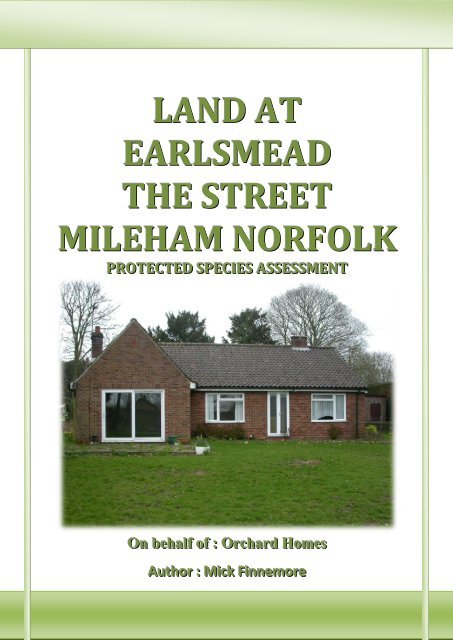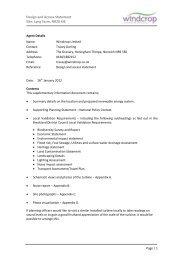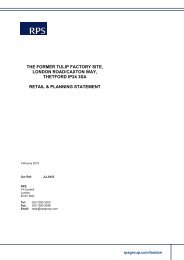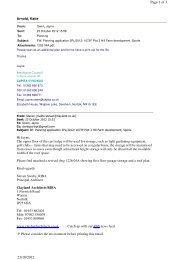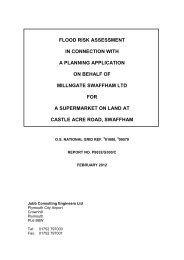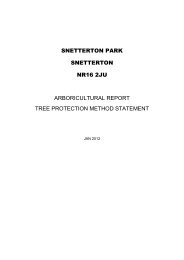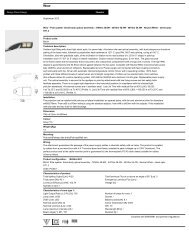view - Breckland Council
view - Breckland Council
view - Breckland Council
You also want an ePaper? Increase the reach of your titles
YUMPU automatically turns print PDFs into web optimized ePapers that Google loves.
Final Report – March 2011 Land at Earlsmead Mileham – Protected Species Assessment<br />
LAND AT<br />
EARLSMEAD<br />
THE STREET<br />
MILEHAM NORFOLK<br />
PROTECTED SPECIES ASSESSMENT<br />
On behallf of : Orchard Homes<br />
Author :: Miick Fiinnemore<br />
1
Final Report – March 2011 Land at Earlsmead Mileham – Protected Species Assessment<br />
Land at Earlsmead<br />
The Street Mileham<br />
Norfolk<br />
* Protected Species Assessment March 2011*<br />
1.0 INTRODUCTION<br />
1.1 Brief<br />
Mick Finnemore was approached by Neil Binks (Orchard Homes) to carry out<br />
a protected species assessment of the above land. The survey was at the<br />
request of the <strong>Breckland</strong> council after Great Crested Newts (GCN) had been<br />
reported to be in the area by a local resident.<br />
A site survey was carried out on the 30 March 2011 by Mick Finnemore and<br />
Phil Jones to assess the presence or absence of great crested newts and the<br />
effect of the proposed development on them. A report detailing the findings<br />
was compiled by Mick Finnemore.<br />
Great crested newts are a species protected under both British and European<br />
legislation.<br />
1.2 Site Location<br />
Earlsmead is located approximately 9.5km directly north-west of Dereham in<br />
the centre of the village of Mileham in the <strong>Breckland</strong> district of Norfolk.<br />
1.3 Site Description<br />
The proposed development land is approximately 6000 2 m in extent and<br />
comprises species poor horse grazed grassland.<br />
It is surrounded on three sides by residential properties although to the north it<br />
is open to grazed pasture then arable fields. Situated at c90m and c95m to the<br />
east and c140m to the north were three former farm ponds.<br />
1.4 Great Crested Newt Legislation<br />
The Great Crested Newt (GCN) is protected through the Wildlife and<br />
Countryside Act (1981), Habitat Regulations (1994) and Countryside Rights<br />
of Way Act (2000). In essence this legislation prohibits the following:<br />
intentional disturbance or harm,<br />
reckless damage to a breeding site or resting place or a place used for<br />
shelter and protection<br />
intentionally obstructing a place used as shelter<br />
2
Final Report – March 2011 Land at Earlsmead Mileham – Protected Species Assessment<br />
2.0 METHODOLOGY<br />
2.1 Building Survey<br />
All adjacent habitats were surveyed using the following methodology: -<br />
(a) Great Crested Newts. This consisted of an initial desktop assessment<br />
looking at Google Earth, Emap Explorer, 1:25000 OS map and Magic.gov<br />
followed by a walk over assessment of the habitats present (both aquatic<br />
and terrestrial) based on c15 years (MF) working knowledge of the species<br />
under the current English Nature license No 2011 0687 and as a committee<br />
member of Norfolk Amphibian and Reptile Group (NARG)<br />
Phil Jones, who has c4 years experience, acts as an agent on the above<br />
license.<br />
A Habitat Suitability Index (HIS) was compiled and should this indicate<br />
suitable breeding habitats being present then further surveys in line with the<br />
present guidelines may be necessary.<br />
2.2 Weather<br />
The weather on the initial survey 30 March 2011 was warm and sunny with a<br />
maximum air temperature of 10 0 c, with a light south-westerly wind. (1 – 2<br />
Beaufort)<br />
2.3 Limitations of Surveys<br />
The timing of the surveys was considered optimal.<br />
3
Final Report – March 2011 Land at Earlsmead Mileham – Protected Species Assessment<br />
3.0 RESULTS<br />
3.1 Aquatic habitats<br />
Two ponds were recorded within<br />
100m of the proposed<br />
development; Pond A, B with a<br />
third, pond C at c140m.<br />
Pond A, the nearest to the<br />
proposed development at c90m<br />
to the east was located in the<br />
garden of a residential property.<br />
It measured approximately<br />
300m 2 by approximately<br />
c600mm of deep half of which<br />
was accumulated sediment and<br />
leaf litter. (See top right)<br />
It was heavily shaded by trees<br />
(Weeping Willows, Sycamore<br />
and Conifer) and ornamental<br />
shrubs and contained no aquatic vegetation at all. The water quality was poor<br />
with no invertebrates being recorded.<br />
A habitat suitability index = 0.462 indication a poor habitat for breeding<br />
GCN.<br />
4<br />
The owners of the property reported<br />
regularly finding adult GCN under<br />
flower pots etc.<br />
Pond B was located approximately<br />
c95m to the east of the proposed<br />
development and was also in the garden<br />
of a residential property although on the<br />
opposite side of The Street. (See left)<br />
It measured approximately 200m 2 . It<br />
was also relatively heavily shaded by<br />
numerous mature trees and contained<br />
limited aquatic vegetation and inverts<br />
such as hog louse, boatmen and<br />
bloodworms.<br />
A habitat suitability index = 0.478<br />
indication a poor habitat for breeding<br />
GCN.<br />
Pond C was located approximately 140m to the north of the proposed
Final Report – March 2011 Land at Earlsmead Mileham – Protected Species Assessment<br />
development and measured approximately 750 m 2 access was not gained for<br />
survey purposes.<br />
3.2 Terrestrial habitats<br />
Pond A was surrounded by excellent<br />
foraging/hibernation habitats<br />
consisting tree roots and riven stone<br />
slabs etc. (See right)<br />
Pond B contained abundant tree<br />
roots but was surrounded by mown<br />
lawns.<br />
Pond C was surrounded by rough<br />
pasture.<br />
The proposed development site itself<br />
had up until quite recently been<br />
recently grazed by 3-4 horses and<br />
therefore consists of mainly bare<br />
ground with a sparse grass cover<br />
along with areas of nettles where the<br />
horse dung had been stored in the<br />
past and contained species indicative of heavily poached grasslands. (See left)<br />
5<br />
Former agricultural buildings<br />
had been removed from the site<br />
prior to purchase by the outgoing<br />
resident. An area had been<br />
disturbed during the removal of<br />
Japanese Knotweed. (A<br />
Notifiable Weed)<br />
To the south of the proposed<br />
development site is the existing<br />
1960’s bungalow which is<br />
surrounded by closely mown<br />
lawns. Set in the lawn close to<br />
the southern boundary wall was a<br />
small raised patio with a loose<br />
un-mortared brick surround,<br />
during a destructive search two<br />
immature GCN’s together with<br />
approximately 10 immature<br />
Smooth Newts were recorded.<br />
Several other suitable refugees<br />
were checked along with slabs forming a patio adjacent to the southern aspect<br />
of the bungalow however these were thought to have limited GCN potential.
Final Report – March 2011 Land at Earlsmead Mileham – Protected Species Assessment<br />
4.0 INTERPRETATION OF RESULTS<br />
4.1 Introduction (GCN)<br />
Great crested newts use a variety of habitats throughout the year but only use<br />
the aquatic environment for approximately 4 months from late February<br />
through to June. The remainder of the time they are to be found foraging in<br />
rough pasture and sheltering under bricks, rubble or logs and under the<br />
footings of old barns and buildings. It is true to say that the immature GCN’s<br />
which may take 3-4 years to mature probably live in low numbers almost<br />
everywhere where they occupy a relatively small foraging area.<br />
Whilst GCN’s were recorded by the owners in the garden around Pond A the<br />
condition of the pond would indicate a poor breeding environment due to little<br />
prey items and the lack of egg<br />
laying vegetation such as water<br />
forgetmenot.<br />
Whilst GCN are occasionally found<br />
in such ponds breeding may only<br />
occur in low numbers. It is<br />
considered that the roadside wall<br />
effectively forms a barrier along<br />
which they move until they find<br />
suitable brick or log piles in which<br />
to shelter.<br />
4.11 Interpretation of Results<br />
The heavily poached grassland with<br />
large areas of bare ground and<br />
regularly mown lawns such as those<br />
found at the development site and<br />
around the existing bungalow are<br />
not a preferred foraging habitat for<br />
GCN’s due to the lack of structure<br />
and limited invertebrate life, they also offer the newts no shelter whilst ranker<br />
areas and tree roosts exist along the roadside wall in the neighbouring gardens.<br />
Therefore using the principle of ‘reasonable likelihood’ it is considered<br />
unlikely that a European Protected Species (EPS) license will be necessary for<br />
the development to commence based on the following rationale:-<br />
No breeding pond will be damaged or lost.<br />
No foraging habitats will be damaged or lost.<br />
No shelter/hibernation habitats will be damaged or lost<br />
The area where the immature newts were found will be carefully rebuilt using<br />
6
Final Report – March 2011 Land at Earlsmead Mileham – Protected Species Assessment<br />
clean bricks and flints plastic sheeting (DPC) (by licensed personnel) to<br />
become a permanent feature (hibernacula) in the south-eastern part of the<br />
garden and a hedgerow of native shrubs will be planted along the roadside.<br />
This and the new hibernacula will ensure that suitable conditions for newts<br />
exist for the future.<br />
The conditions contained in the method statement are to be strictly adhered to<br />
and be displayed in the site office along with the contact telephone number of<br />
the consultant ecologist.<br />
Whilst access to Pond C was not gained it was c140m away and therefore<br />
outside of the 100m zone suggested by the latest Natural England ‘standing<br />
advice’ and would have no significant effect on the proposed development.<br />
7
Final Report – March 2011 Land at Earlsmead Mileham – Protected Species Assessment<br />
5.0 RECOMMENDATION<br />
5.1 To ensure that areas of lawns remain unsuitable for the newts it should be<br />
mown weekly both up to and during the development but leaving the current<br />
area of ranker grassland adjacent to the wall. (c2m width) which will be<br />
planted in the next available planting season (Autumn 2011)<br />
5.2 Enhancement – Great crested newts<br />
5.2.1 Introduction<br />
Under the Natural Environment and Rural Communities Act 2006 bio-<br />
diversity has to be taken into consideration at all levels of planning and this<br />
has been interpretated as a series of wildlife enhancements.<br />
Our wildlife and especially newts use hedgerow and other corridors such as<br />
ditch lines where coarse vegetation exists along which to move, and often a<br />
fragmented hedgerow can cause an obstruction to that movement. Therefore to<br />
ensure both a unmown corridor and foraging habitat exists a native species<br />
hedgerow 50m in length will be planted along the roadside wall using species<br />
found in the following table.<br />
ENGLISH NAME LATIN NAME %<br />
Hawthorn Crataegus monogyna 75<br />
Blackthorn Prunus spinosa 15<br />
Hazel Corylus avellana 5<br />
Field Maple Acer campestre 5<br />
Dogwood Cornus sanquinia 2.5<br />
Guelder Rose Viburnum opulus 2.5<br />
The transplants should be planted on staggered rows at 5 per metre and<br />
protected from rabbit damage via the use of spiral rabbit guards and be well<br />
watered especially during the initial planting period and summers and weeded<br />
annually for the first 2 years. They can be selectively coppiced afterwards to<br />
ensure a low bushy growth.<br />
5.3 Follow-up Visits – GCN<br />
Further site visits to ensure all rubble piles are checked by licensed personnel<br />
and to build the hibernacula.<br />
8
Final Report – March 2011 Land at Earlsmead Mileham – Protected Species Assessment<br />
6.0 APPENDIX<br />
6.1 Re<strong>view</strong> of GCN Ecology<br />
Introduction<br />
Whilst considered an aquatic creature newts in fact only use the pond<br />
environment for a short period every year to breed. They leave their winter<br />
hibernation site in late February when the evening air temperature is above<br />
about 5 0 c and enter suitable breeding ponds, the males first later followed by<br />
the females and immature.<br />
A good breeding pond is not too shaded with a good invertebrate life and<br />
abundant vegetation growing in shallow edges especially species such as water<br />
mint and water forgetmenot. These soft leaved plants are chosen by the female<br />
GCN for egg laying and each egg is carefully attached and the leaf is the<br />
folded to form a protective envelope. Hatching is weather dependant so warm<br />
sunny shallows are often a favoured place. The young newts – efts – are<br />
vulnerable to predation at this time by fish and large water beetles etc<br />
therefore a fishless pond is most important and one which occasionally dries<br />
out – therefore a group of ponds in a particular habitat are important.<br />
By mid/late July many of the adult newts will have left the pond and will be<br />
found in pasture or woodland edges with abundant cover and places such as<br />
tree roots and log piles for shelter whilst this is often used around the pond<br />
GCN have been known to move considerable distances away from it. As<br />
autumn approaches the young newts will also leave the pond perhaps<br />
following scent trails left by the adults and will live in the locality for 2-4<br />
years before visiting the pond as an immature newt. At the onset of winter the<br />
newts seek a hibernation site beneath brick piles or the foundations of barns<br />
and other old building away from the winter frosts.<br />
6.2 Bibliography<br />
Great crested newt mitigation guidelines English Nature 2001<br />
Great crested newt conservation handbook Froglife 2001<br />
Opportunities for amphibians and reptiles in the designed landscape No 30<br />
English Nature Science Series 1997<br />
Conservation and management of Great crested newts No 20 English Nature<br />
1994<br />
Guide to the reptiles and amphibians of Britain and Ireland AIDGAP Field<br />
Studies <strong>Council</strong><br />
Great Crested Newts and Development Guidance for Development Control<br />
Officers Natural England East Region<br />
6.3 Useful Contacts<br />
Emma Crick Natural England Suffolk and Norfolk Team , Government<br />
Buildings, 100 Southgate Street, Bury St Edmunds, Suffolk, IP33 2FE Tel:<br />
0300 060 2493<br />
Wildlife Administration Unit DEFRA Burghill Road Westbury – on Trym<br />
Bristol BS10 6NJ Tel 0845 6014523<br />
9
Final Report – March 2011 Land at Earlsmead Mileham – Protected Species Assessment<br />
Mick Finnemore (Ecologist) Laurel Cottage Pottergate Street Aslacton<br />
Norfolk NR15 2JU Tel 01508 531233 Email micky.finn@virgin.net<br />
10
Final Report – March 2011 Land at Earlsmead Mileham – Protected Species Assessment<br />
APPENDIX I<br />
METHOD STATEMENT<br />
11
Final Report – March 2011 Land at Earlsmead Mileham – Protected Species Assessment<br />
METHOD STATEMENT<br />
1. All open trenches, footings, and pipe runs should be covered with shuttering ply<br />
overnight and the edges sealed with damp sand.<br />
2. All open gaps between walls and adjacent earth should be sealed with earth or<br />
sand and rechecked after periods of rain.<br />
3. All caustic materials (cement lime plaster etc) should be mixed on tarpaulin and<br />
folded at night or on the floor or on the floor of a sealed building.<br />
4. No caustic material should be allowed to contaminate the adjacent ground or<br />
allowed to form run-off which may contaminate the adjacent pond.<br />
5. All materials should be stored on areas of barge ground/shingle and NOT on areas<br />
of vegetated ground or stored off the ground on pallets.<br />
6. All piles of rubble and spoil should be removed from site and not left during late<br />
summer – winter to form hibernacula for newts etc.<br />
7. All waste materials to be stored in skips resting on areas of shingle or hard<br />
standing.<br />
8. Keep vegetation around the buildings to be developed short to discourage use by<br />
amphibians.<br />
9. No materials to be burnt on site except in the designated area. All material should<br />
be burnt by the end of the day.<br />
10. If any great crested newts are discovered during the redevelopment then work<br />
should stop immediately and the consultant informed.<br />
11. If in any doubt contact the consultant - Mick Finnemore (Tel 01508 531233)<br />
NOTE: A copy of this method statement should be on <strong>view</strong> in the site office.<br />
12
Final Report – March 2011 Land at Earlsmead Mileham – Protected Species Assessment<br />
APPENDIX II<br />
HISTORICAL GCN RECORDS<br />
FOR THE LOCALITY<br />
(NARG 2011)<br />
13
Final Report – March 2011 Land at Earlsmead Mileham – Protected Species Assessment<br />
Great Crested Newt Records for the Milham area (NARG - 2011)<br />
Taxon Vernacular Site Gridref VC Qty Date Recorder Method Comment<br />
Triturus cristatus Warty Newt / Great Crested Newt East Bilney - Wood TF960190 28 1m 16 May 2003 Philip Parker Field record / observation<br />
Triturus cristatus Warty Newt / Great Crested Newt East Bilney - Wood TF960190 28 2f 16 May 2003 Philip Parker Field record / observation<br />
Triturus cristatus Warty Newt / Great Crested Newt East Bilney - Wood TF960190 28 3f 25 May 2003 Philip Parker Field record / observation<br />
Triturus cristatus Warty Newt / Great Crested Newt East Bilney - Wood TF960190 28 1f 07 Jun 2003 Philip Parker Field record / observation<br />
Triturus cristatus Warty Newt / Great Crested Newt (Herps) Brisley TF9521 28 0 1961 u 0 recorded from pond at Brisley Green and<br />
general area.<br />
Triturus cristatus Warty Newt / Great Crested Newt (Herps) Brisley TF9521 28 0 14 May 2005 u 0 No other details available when input.<br />
I suspect that this is the same record as 229 by Miss D.M.Maxey - JGG<br />
Triturus cristatus Warty Newt / Great Crested Newt (Herps) Beeston with Bitte TF944168 28 17 02 Apr 1988 u 0 caught with net & released.<br />
Triturus cristatus Warty Newt / Great Crested Newt (Herps) Tittleshall TF909209 28 1 30 Mar 1983 u 0 at Eastfield Wood.<br />
Triturus cristatus Warty Newt / Great Crested Newt (Herps) Brisley TF9421 28 0 18 May 2005 u 0 recorded in 1965 and since.<br />
Triturus cristatus Warty Newt / Great Crested Newt (Herps) Tittleshall TF9021 28 0 18 May 2005 u 0 in Eastfield Wood in water<br />
tanks and on other side of road.<br />
Triturus cristatus Warty Newt / Great Crested Newt (Herps) Stanfield TF9320 28 0 1987 u 0 came into house and found in garden<br />
esp. autumn at High Farm, Stanfield, NR20 4JD. House now for sale (Will H. Brown, Dereham) Mrs Bryan now concerned for newts with new owner.<br />
Triturus cristatus Warty Newt / Great Crested Newt (Herps) Brisley TF9520 28 0 22 Jun 2005 u 0 Record from John Buckley. In<br />
ponds on land<br />
Triturus cristatus Warty Newt / Great Crested Newt (Herps) Mileham TF920195 28 0 26 Jun 1905 u 0 A deep ditch and pond which<br />
border our property contain a sizeable population of GCN. Last summer the offspring were so abundant that it was impossible not to catch several at a time when cleaning blanket<br />
weed. In addition several colonies of smooth newts, plus toads and frogs. I hope this is of sufficient interest to register the GCN as a protected species in this location. The pond is on<br />
<strong>Council</strong> land though the ditch is on mine.<br />
Triturus cristatus Warty Newt / Great Crested Newt (Herps) Pipeline Pond 034 TF913210 28 10 06 Mar 2003 Ian Tanner Field record / observation<br />
Breeding<br />
Triturus cristatus Warty Newt / Great Crested Newt (Herps) Pipeline Pond 041 TF929219 28 1 07 Mar 2003 Ian Tanner Field record / observation<br />
MapMate: 10:03 Thu 24 Mar 2011<br />
14


